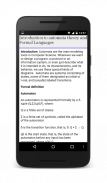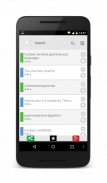









Automata theory

Description de Automata theory
Automata theory is the study of abstract machines and automata. It is a theory in theoretical computer science, & discrete mathematics. Automata comes from the Greek word αὐτόματα meaning "self-acting".
The app is classroom notes on the subject for Information technology (IT), Computer Science engineering, discrete mathematics & Mathematics students.
The purpose of the App is faster learning of the subject and quick revisions of the topics. The Topics are created in manner to quickly absorb the subject.
It covers 138 topics of Automata in detail. These 138 topics are divided in 5 units.
Some of topics Covered in this application are:
1. Introduction to automata theory and Formal Languages
2. Finite automata
3. Deterministic finite state automaton (DFA)
4. Sets
5. Relations and Functions
6. Asymptotic Behavior of Functions
7. Grammar
8. Graphs
9. Languages
10. Nondeterministic finite automaton
11. Strings and Languages
12. Boolean Logic
13. Orders for Strings
14. Operations on languages
15. Kleene Star, ‘∗’
16. Homomorphism
17. Machines
18. The power of DFAs
19. Machine types that accept non-regular languages
20. Equivalence of NFA and DFA
21. Regular Expressions
22. Regular Expressions and Languages
23. Building Regular Expressions
24. NFAs to Regular Expression
25. Two-way Finite Automata
26. Finite Automata with Output
27. Properties of regular sets (Languages)
28. Pumping Lemma
29. Closure properties of regular languages
30. Myhill-Nerode Theorem-1
31. Introduction to Context-Free Grammars
32. Conversion of Left-linear Grammar into Right-Linear Grammar
33. Derivation Tree
34. Parsing
35. Ambiguity
36. Simplification of CFG
37. Normal Forms
38. Greibach Normal Form
39. Pushdown Automata
40. Transition Functions for NPDA
41. Execution of NPDA
42. Relation between pda and context free language
43. CFG to NPDA
44. NPDA to CFG
45. Properties of context-free languages
46. Proof of Pumping Lemma
47. Usage of Pumping Lemma
48. dicision Algorithms
49. Turing Machine
50. Programming a Turing Machine
51. Turing Machines as Transducers
52. Complete language and functions
53. Modification of turing machines
54. Church-turing thesis
55. Enumerating Strings in a Language
56. Halting Problem
57. Rice's Theorem
58. Context sensitive grammar and languages
59. The chomsky hirarchy
60. Unrestricted grammar
61. Introduction to Complexity Theory
62. polynomial time algorithm
63. boolean satisfiablity
64. Additional NP problem
65. Formal systems
66. Composition and recursion
67. Ackermann's theorem
68. Propositions
69. Exampleof Non Deterministic Finite Automata
70. Conversion of NFA to DFA
71. Connectives
72. Tautology, Contradiction and Contingency
73. Logical Identities
74. Logical inference
75. Predicates and quantifiers
76. Quantifiers and logical operators
77. Normal forms
78. Mealy and moore Machine
79. Myhill-Nerode theorem
80. Decision algorithms
81. NFA with ε-moves
82. Binary Relation Basics
83. Transitive, and Related Notions
84. Equivalence (Preorder plus Symmetry)
85. The Power Relation between Machines
86. Dealing with Recursion
87. The Y operator
88. The least fixed-point
89. Error-correcting DFAs
90. Ultimate Periodicity and DFAs
91. The Automaton/Logic Connection
92. Binary Decision Diagrams (BDDs)
93. Basic Operations on BDDs
94. Stabilization at a Fixed-Point
95. A Taxonomy of Formal Languages and Machines
96. Introduction to Push-down Automata
97. Right- and Left-Linear CFGs
98. Developing CFGs
99. A Pumping Lemma for CFLs
100. A Pumping Lemma for CFLs
101. Acceptance, Halting, Rejection
102. NDTMs
IMPORTANT LINKS
Feedback: Share your feedback at essyengineering@gmail.com
Social links
Facebook : https://www.facebook.com/EngineeringEasy/
Twitter : https://twitter.com/easyengineerin
Website:http://www.engineeringapps.net/
</div> <div jsname="WJz9Hc" style="display:none">la théorie des automates est l'étude des machines abstraites et des automates. Il est une théorie de l'informatique théorique, et mathématiques discrètes. Automates vient du mot grec αὐτόματα signifie «auto-action".
L'application est notes en classe sur le sujet pour la technologie de l'information (TI), ingénierie informatique, mathématiques discrètes et étudiants en mathématiques.
Le but de l'application est un apprentissage plus rapide des révisions sujet et rapides des sujets. Les sujets sont créés de manière à absorber rapidement le sujet.
Il couvre 138 sujets de Automates en détail. Ces 138 sujets sont divisés en 5 unités.
Certains des sujets abordés dans cette application sont:
1. Introduction à la théorie et des automates formels Langues
2. Automates finis
3. déterministes automate à états finis (DFA)
4. Ensembles
5. Relations et fonctions
6. Comportement asymptotique des fonctions
7. Grammaire
8. Graphiques
9. Langues
10. non déterministes automate fini
11. Cordes et Langues
12. logique booléenne
13. Les commandes de Cordes
14. Opérations sur les langues
15. Kleene Star, à ¢ â,¬ËœÃ ¢ Ë † â € "à ¢ â" ¢
16. homomorphisme
17. Machines
18. La puissance de DFA
19. Types de machines qui acceptent des langues non réguliers
20. Equivalence de NFA et DFA
21. Les expressions régulières
22. Les expressions régulières et des Langues
23. Construction d'expressions régulières
24. NFAs à Expression régulière
25. Automates Deux voies Finite
26. Automates finis avec sortie
27. Propriétés des ensembles réguliers (Langues)
28. Pumping Lemma
29. propriétés de fermeture de langues régulières
30. Myhill-Nerode Théorème-1
31. Introduction à contexte grammaires
32. La conversion de Gauche linéaire Grammaire en droit linéaire-Grammar
33. Derivation Tree
34. Parsing
35. ambiguïté
36. Simplification de CFG
37. formes normales
38. forme normale de greibach
39. Pushdown Automates
40. Fonctions de transition pour NPDA
41. Exécution de NPDA
42. Relation entre pda et langage algébrique
43. CFG à NPDA
44. NPDA à CFG
45. Propriétés des langages hors-contexte
46. Preuve de pompage Lemme
47. Utilisation de pompage Lemme
48. Algorithmes dicision
49. Machine de Turing
50. Programmation d'une machine de Turing
51. Turing Machines comme Transducteurs
52. langue et fonctions complètes
53. Modification des machines de Turing
Church-Turing 54. thèse
55. L'énumération des chaînes dans une langue
56. Stopper problème
57. Théorème de riz
58. Contexte grammaire et langues sensibles
59. Le hirarchy de chomsky
60. grammaire Unrestricted
61. Introduction à la théorie de la complexité
62. algorithme polynomial
63. satisfiablity booléen
64. additionnel problème NP
65. Les systèmes formels
66. Composition et récursivité
Le théorème de 67. Ackermann
68. Propositions
69. Exampleof non déterministes Automates finis
70. La conversion de NFA à DFA
71. Les connecteurs
72. tautologie, Contradiction et contingence
73. Identités logiques
74. inférence logique
75. prédicats et quantificateurs
76. quantificateurs et des opérateurs logiques
77. Les formes normales
78. Mealy et moore machine
79. Myhill-Nerode théorème
80. algorithmes de décision
81. NFA avec ÃŽÂμ-moves
82. Principes de base des relations binaires
83. transitive et Mercerie connexes
84. Equivalence (Précommande, plus Symétrie)
85. Le rapport de force entre les machines
86. Traiter avec Recursion
opérateur 87. Le Y
88. Le point fixe moins
89. DFA correcteurs d'erreurs
90. Ultime Périodicité et DFA
91. Le Automaton / Logic Connection
92. Les diagrammes de décision binaires (BDDs)
93. Opérations de base sur les BDD
94. La stabilisation à un point fixe
95. Une taxonomie des langues et Machines formelles
96. Introduction à pousser vers le bas Automates
97. à droite et à gauche GFR-linéaires
98. CFG développement
99. Un pompage lemme des LFC
100. Un pompage lemme des LFC
101. L'acceptation, de l'arrêt, Rejet
102. NDTMs
LIENS UTILES
Commentaires: Partagez vos commentaires à essyengineering@gmail.com
liens sociaux
Facebook: https://www.facebook.com/EngineeringEasy/
Twitter: https://twitter.com/easyengineerin
Site Web: http: //www.engineeringapps.net/</div> <div class="show-more-end">

























